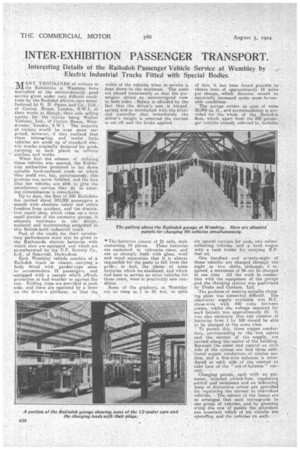1NTER-EXHIBITION PASSENGER TRANSPORT.
Page 20

If you've noticed an error in this article please click here to report it so we can fix it.
Intercsting Details of the Railodok Passenger Vehicle Service at Wembley by Electric Industrial Trucks Fitted with Special Bodies.
MANY THOUSANDS of visitors to
theExhibition at Wembley have marvelled at. the extraordinarily good sei vice given under very difficult conditions by the Railodok electric cars mann • factmed by G. D. Peters and Co., -Ltd., . of CaNton. Rouse, London, S.W.1, at their works at Slough, their eole selling agents for the trucks being Walker Vehicles, Ltd., of Caxton House, Westininster, London,S.W.1. The majority of visitors would be even more surprised, however, if they /realized that. these interepting anduseful little vehicles are made up of standard eleetric trucks originally designed for goods carrying at such places as railway
• station's and works.
When first the scheme of .utilizing these vehicles was mooted, the Exhibi.
• tion authorities promised to lay down suitable hard-surfaced roads on which they could run, but, unfortunately, this pi omiSe was never fulfilled, and the fact that the vehicles are able to give the satisfactory service theydo in existing circumstances is remarkable.
Up to date, the fleet of 200 Railodoks has carried about 300,000 passengers a month with absolute safety and entire freedom from accident, and the diminutive repair shop, which takes up a very small portion of the extensive garage, is elequent testimony to the design, material and workmanship emLedied in this British-built industrial truck
Part of the credit for their satisfactory performance must also he given to the Kathanode electric batteries with which they are equipped, and which are manufactured by the D.P.. Battery Co„ Ltd.,of Bakewell, Derbyshire,
Each Wembley vehicle consists of .a Railodok truck as chassis, carrying a body fitted with garden-typo seats to accommodate 12 passengers, and -equipped with a canopy which affords protection in bad weather or against the sun. Folding steps-are provided at. each side, and these are operated by a lever on the driver's platform, so that the
width of the vehicles when in service is kept down -to the minimum, The seats are placed transversely so that the passengers obtain an uninterrupted view to both sides. -Safety is afforded by the fact that the driver's seat is hinged, sprung and so interlocked with the brake and controller that immediately the driver's weight is removed the current is cut off and the brake applied.
"The.hatteries consist of 21 cells, each
containing 19 plates.. These batteries are contained in vulcanite cases, arid are so strongly built with glass, wool and wood separators that it is almost impossible for the paste to fall from the grids; in fact, the .plates of some batteries which we examined, and which had been in service on other vehicles for three years, were in practically new condition, Some of the gradients at. -Wembley are as steep as 1 in 10, but, in spite
of this, it has been found possible to . obtain runs, of approximately 18 miles per charge, which distance would he materially.increased under more favourable conditiona.
' The garage covers an area of some 20,000 sq. ft. and accommodation is provided for 04 whole Of the Railodok. fleet, which, apart frem the 200 passen•, ger vehicles already referred to, includes
six special citriers for cash, two refuse• collecting, vehicles and a tank wii,L111 with a tank trailer for carrying B.P. fuel oil.
One hundred and seventy-eight of these vehicles are charged through the night in two shifts, although, if required, a maximum of 96 can be charged at one time . All the work in connec• tion with the equipment -of 'the garage and the charging station was performed by Drake and Gorham, Ltd. The problem of making suitable charging plant u-as somewhat. difficult.. The electricity supply available was D.C. three-wire with 440 ,volts between enters, whilst the voltage required for each battery was approximately 55. It was also necessary that -any number of batteries from I to 100 should be able to be charged at the same time. Tc,t permit this, three copper conductors, corresponding to the two outers and the neutral of the supply, are carried along the centre of the building. Between the outer and neutral on each side of the system are laid three additional copper conductors of similar section, and a five-Wire balancer is introduced at etch side of the neutral to take -care of the "out-of-balance " current. •. .
-Charging panels, each with an ammeter, Ironclad switch-fuse, regulating switch and 'resistance and an indicating lamp of distinctive colour are provided for regulating' the eurrent tri individual vehicles. The ea/ours of the lamps are' so' arlianged that each coiresponds to one group of vehicles, arid by 'glancing a'ong the row of panels the attendant . can ascertain which of his cireuits are operating and the vehicles on each,






























